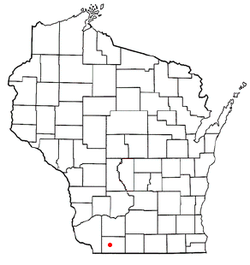Seymour, Lafayette County, Wisconsin
From Wikipedia, the free encyclopedia
Jump to: navigation, search
For other towns named Seymour in Wisconsin, see Seymour, Wisconsin (disambiguation).
Seymour, Wisconsin

Location of Seymour, Wisconsin
Coordinates:  42°39′7″N 90°14′58″W / 42.65194°N 90.24944°W / 42.65194; -90.24944Coordinates:
42°39′7″N 90°14′58″W / 42.65194°N 90.24944°W / 42.65194; -90.24944Coordinates:  42°39′7″N 90°14′58″W / 42.65194°N 90.24944°W / 42.65194; -90.24944
42°39′7″N 90°14′58″W / 42.65194°N 90.24944°W / 42.65194; -90.24944
Area
• Total
36.1 sq mi (93.6 km2)
• Land
36.1 sq mi (93.6 km2)
• Water
0.0 sq mi (0.0 km2)
Elevation[1]
1,043 ft (318 m)
Population (2000)
• Total
363
• Density
10.0/sq mi (3.9/km2)
Time zone
Central (CST) (UTC-6)
Seymour is a town in Lafayette County, Wisconsin, United States. The population was 363 at the 2000 census. The unincorporated community of Seymour Corners is located in the town.
Geography[edit]
According to the United States Census Bureau, the town has a total area of 36.1 square miles (93.6 km²), all of it land.
Demographics[edit]
As of the census[2] of 2000, there were 363 people, 118 households, and 96 families residing in the town. The population density was 10.0 people per square mile (3.9/km²). There were 122 housing units at an average density of 3.4 per square mile (1.3/km²). The racial makeup of the town was 99.72% White and 0.28% Native American.
There were 118 households out of which 46.6% had children under the age of 18 living with them, 72.0% were married couples living together, 2.5% had a female householder with no husband present, and 17.8% were non-families. 16.1% of all households were made up of individuals and 5.1% had someone living alone who was 65 years of age or older. The average household size was 3.08 and the average family size was 3.45.
In the town the population was spread out with 36.9% under the age of 18, 5.5% from 18 to 24, 30.0% from 25 to 44, 18.7% from 45 to 64, and 8.8% who were 65 years of age or older. The median age was 32 years. For every 100 females there were 111.0 males. For every 100 females age 18 and over, there were 120.2 males.
The median income for a household in the town was $40,000, and the median income for a family was $40,536. Males had a median income of $25,417 versus $22,917 for females. The per capita income for the town was $13,390. About 10.9% of families and 14.1% of the population were below the poverty line, including 20.3% of those under age 18 and 6.5% of those age 65 or over
Lafayette County, sometimes spelled La Fayette County, is a county located in the U.S. state of Wisconsin. It was part of the Wisconsin Territory at the time of its founding. As of the 2010 census, the population was 16,836.[1] Its county seat is Darlington.[2] The county was named in honor of the Marquis de Lafayette, the French general who rendered assistance to the Continental Army in the American Revolutionary War.[3]
Geography[edit]
According to the U.S. Census Bureau, the county has a total area of 635 square miles (1,640 km2), of which 634 square miles (1,640 km2) is land and 1.0 square mile (2.6 km2) (0.2%) is water.[4]
Major highways[edit]
 U.S. Highway 151
U.S. Highway 151  Highway 11 (Wisconsin)
Highway 11 (Wisconsin)  Highway 23 (Wisconsin)
Highway 23 (Wisconsin)  Highway 78 (Wisconsin)
Highway 78 (Wisconsin)  Highway 81 (Wisconsin)
Highway 81 (Wisconsin)  Highway 126 (Wisconsin)
Highway 126 (Wisconsin)
Adjacent counties[edit]
- Grant County - west
- Iowa County - north
- Green County - east
- Stephenson County, Illinois - southeast
- Jo Daviess County, Illinois - south
Demographics[edit]
2000 Census Age Pyramid for Lafayette County
U.S. Decennial Census[6]
1790–1960[7] 1900–1990[8]
1990–2000[9] 2010–2014[1]
As of the census of 2000,[10] there were 16,137 people, 6,211 households, and 4,378 families residing in the county. The population density was 26 people per square mile (10/km²). There were 6,674 housing units at an average density of 10 per square mile (4/km²). The racial makeup of the county was 99.03% White, 0.11% Black or African American, 0.11% Native American, 0.22% Asian, 0.04% Pacific Islander, 0.14% from other races, and 0.35% from two or more races. 0.57% of the population were Hispanic or Latino of any race. 33.8% were of German, 17.5% Norwegian, 13.6% Irish, 11.9% English, 6.8% Swiss and 6.0% American ancestry.
There were 6,211 households out of which 33.30% had children under the age of 18 living with them, 59.00% were married couples living together, 7.60% had a female householder with no husband present, and 29.50% were non-families. 25.40% of all households were made up of individuals and 13.10% had someone living alone who was 65 years of age or older. The average household size was 2.57 and the average family size was 3.10.
In the county, the population was spread out with 27.20% under the age of 18, 7.60% from 18 to 24, 27.20% from 25 to 44, 22.10% from 45 to 64, and 15.80% who were 65 years of age or older. The median age was 38 years. For every 100 females there were 99.80 males. For every 100 females age 18 and over, there were 98.00 males.












